Thimmamma Marrimanu: The world’s largest single tree canopy
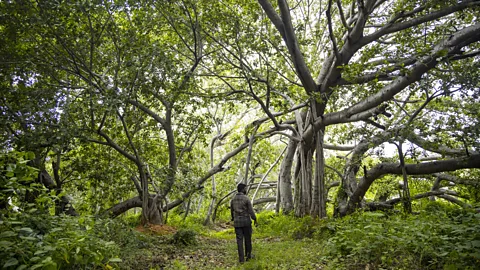 Chris Griffiths
Chris GriffithsFlourishing within one of India’s driest regions, Thimmamma Marrimanu has become an enduring symbol of eternal life – and it continues to grow through recent conservation efforts.
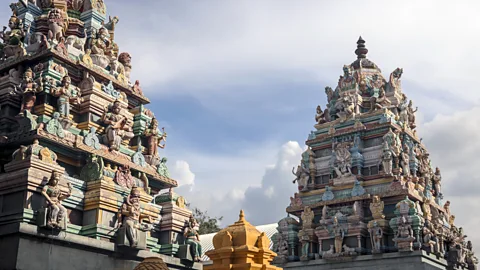 Chris Griffiths
Chris GriffithsCompared to other destinations in India, Andhra Pradesh in the country’s south-east may not rank highly on popular tourist itineraries. However, it’s India’s most most-visited state domestically, with more than 120 million people flocking here annually. The majority of them are Hindu pilgrims journeying to Tirupati, a city that holds one of the world’s wealthiest temples and most frequented sacred sites.
From Tirupati, pilgrims often tour the state’s southern areas, heading for the town of Puttarpathi, home of the late – and controversial – spiritual guru Sathya Sai Baba; to a mysterious, gravity-defying stone pillar suspended from the ceiling at Lepakshi Temple; and to practice darshan (the beholding of a deity, holy person or sacred object) at the Sri Lakshmi Narasimha temple in the town of Kadiri (pictured).
But one more, somewhat unexpected, place of pilgrimage lies tucked away in the rocky valleys 25km south-east of Kadiri: a natural wonder that holds a Guinness World Records title.
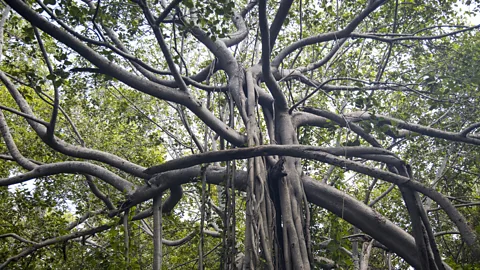 Chris Griffiths
Chris GriffithsFlourishing within one of India’s driest regions is Thimmamma Marrimanu, the world’s largest single tree canopy. The banyan tree was first added to the Guinness Book of World Records in 1989 (its entry updated in 2017) as being 550 years old and having the “greatest perimeter length for a tree”, spreading over five acres with a circumference of 846m.
Much of this global recognition was due to the work of Sathyanarayana Iyer, a journalist who humorously changed his name to “Regret Iyer” after receiving many “letters of regret” from publications regarding his story ideas. His 1989 discovery about Thimmamma Marrimanu, however, was a success, confirming one of the writer-photographer’s speculations – based on rumours he had heard and a subsequent investigation – that Andhra Pradesh was home to a huge banyan tree.
Landmark Trees of India, a survey conducted between 2008 and 2010 by Outreach Ecology, measured the canopies of banyan trees across the country and found that India is in fact home to seven of the largest banyan trees in the world. They also confirmed more recently that Thimmamma Marrimanu is the largest of them all. However, the banyan’s size has become a matter of debate as the local forestry department argues that the tree has actually spread over eight acres due to conservation efforts over the past two years and is 660 years old.
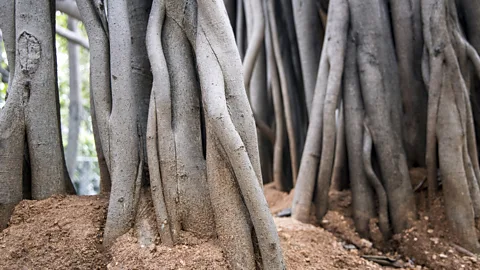 Chris Griffiths
Chris GriffithsThe banyan (Ficus benghalensis), also called Indian banyan or banyan fig, is part of the mulberry family and is native to the Indian subcontinent. Stretching outward in every direction, it looks more like a grove or a forest than a single tree. Considered a “strangler” tree, it begins life as an epiphyte, a plant that grows on the surface of another plant, first by planting seeds in the branches of other trees and then by sprouting vine-like roots that block the host tree of sunlight as they wind down and eventually anchor themselves into the forest floor. These roots then spread underground, depriving all other nearby plants of water and nutrients, using these resources to then thicken into big pillars that look like tree trunks. The banyan will keep growing and expanding as far as its surroundings permit.
Thimmamma Marrimanu has more than 4,000 roots making up its canopy. It has been damaged by cyclones and droughts over the centuries, with large clumps of well-established roots having fallen sideways or broken off completely. But nevertheless, the tree is still expanding. The small collection of dusty mountains in which it is nestled provides a small, bowl-like clearing that allows for good drainage and sunlight with plenty of room for the tree to grow.
 Chris Griffiths
Chris GriffithsThe banyan is considered India’s national tree, and its constant expansion and regrowth is seen as a symbol of eternal life, particularly in the Hindu religion. Over time, the tree has also become a world-famous symbol of fertility, life and resurrection. Followers of Hinduism, Buddhism and other religions often tie ribbons to the branches of banyans, which now grow throughout South-East Asia, and place small shrines with religious icons at their roots.
In the Bhagavad Gita, an ancient Sanskrit scripture that’s part of the Hindu epic Mahabharata, the banyan tree’s “upward roots and downward branches” form a poetic metaphor for there being something illusionary about this world, conveying reality as a shadowy reflection of the spiritual world. But while banyan trees grow in temple courtyards throughout India, Thimmamma Marrimanu is so large that it holds an entire temple at its centre.
 Chris Griffiths
Chris GriffithsAlthough not directly referenced in the Bhagavad Gita, Thimmamma Marrimanu has its own legend associated with it. Hindus believe that a woman named Thimmamma performed sati (the practice of a widow immolating herself on her husband’s funeral pyre) in 1433 in the exact place the banyan tree grows. According to the legend, her husband had been suffering from leprosy and eventually ed away from the disease, and as a devoted wife who had sworn eternal love for her spouse, she could not bear the pain of losing him.
It is said that one of the poles ing the pyre rooted into the ground, allowing Thimmamma to be transformed into the tree and become a goddess. Many believe that the tree has mystical powers and is able to bless childless couples with the gift of fertility.
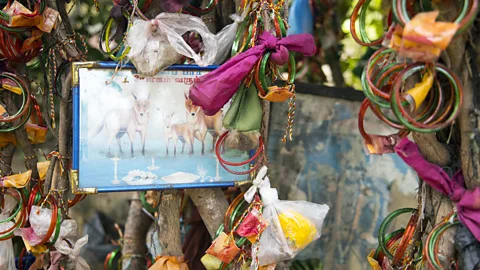 Chris Griffiths
Chris GriffithsThere is a very strong local belief that if [a couple] ties a saffron ribbon onto the tree, the goddess will bless [them] with fertility within one year,” said Anil Kumar, tour guide at Thimmamma Marrimanu.
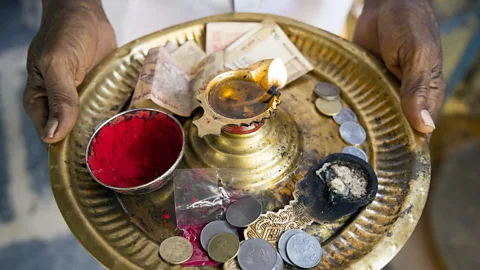 Chris Griffiths
Chris GriffithsPilgrims remove their shoes before entering the vicinity of the sacred tree canopy. After walking down a dusty path into the heart of the banyan, they first bow and pray to Nandi, a bull deity who acts a gate-guardian for the samadhi (funerary monument) created as a memorial for Thimmamma and dedicated to Lord Shiva, the god of destruction and rebirth. Next, they visit a small shrine that houses icons of Thimmamma and her husband, to which they offer food such as coconut and spices.
Before approaching the main shrine facing the samadhi, which houses a black stone icon of Thimmamma, pilgrims are blessed by a priest waving a candle flame before them. After listening to a local guide tell the story of the goddess’ sacrifice, they circle the samadhi five times to the right, which symbolises walking the “right” path in life.
The samadhi is believed to be the exact spot where Thimmamma threw herself onto the funeral pyre. In 2001, an excavation uncovered old bangles and other jewellery at the centre of the tree, which reinforced this belief and led to instructions being sent by priests and officials in Tirupati to build a temple in that exact spot. The temple complex at Thimmamma Marrimanu is a relatively new addition to the site, at only around a decade old.
 Chris Griffiths
Chris GriffithsThere are many more local legends surrounding the tree besides the story of Thimmamma. For example, a white temple at the base of a mountain opposite the site’s main entrance is said to be a place where Lord Shiva worshipped and performed penance rituals. Locals also believe that Lord Vishnu enjoys relaxing on top of the great banyan.
Many also believe that the sheer numbers of people and priests who have prayed at the site throughout the ages has charged the tree with a positive energy that aids in its massive growth. Each year, over the course of just four days in February or March, droves of people stand under its canopy during Maha-Shivaratri, the national Festival of Shiva, to perform special prayers and rituals.
 Chris Griffiths
Chris GriffithsMany pilgrims believe that with the tree can channel positive energy that’s good for the body, mind and soul. They’ll stand hugging its main roots, often for upwards of 10 minutes at a time, often chanting holy mantras.
The healing power of trees is perhaps not as far out as it may seem. After all, they provide the Earth with breathable air, something we can’t live without, and many medicines are derived from trees. For example, aspirin comes from willow bark, and melaleuca oil derived from leaves of the Australian tea tree is widely used for skin infections. Additionally, research shows that being among natural green spaces like forests significantly reduces blood pressure and stress levels, and Japan has embraced the concept of forest bathing to promote wellness.
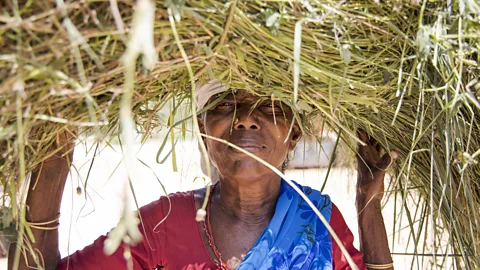 Chris Griffiths
Chris GriffithsUnfortunately though, when it comes to Thimmamma Marrimanu, the benefits can be both a blessing and a curse, with some fearing that increased visitor numbers are threatening the tree’s very existence. Large crowds, especially those that arrive during the annual festival, are thought to be damaging its roots.
On a positive note, though, humans are also helping to protect the tree. Workers from the local forestry department make regular visits to strengthen and nourish its roots by adding soil to them with hollow bamboo poles, and are also placing stone plinths around the tree to damaged branches. Groundskeepers maintain a path for pilgrims to stay on when inside the canopy.
However, perhaps the most important helping hand comes in the form of an insect. All fig trees – including Thimmamma Marrimanu – are pollinated by the fig wasp, which uses the trees’ natural habitat to lay its eggs. Small red figs growing at the northern edge of the canopy attract fig wasps for egg laying, which then pollinate the giant banyan, helping it grow.
 Chris Griffiths
Chris GriffithsThe peaceful and secluded setting that surrounds Thimmamma Marrimanu makes it hard to believe that Bangalore – India’s third most populated city – lies less than 180km south-west. Instead of hustle and bustle, the tree is alive with the birdsong of parrots and doves, flying foxes hang from branches within the canopy, and monkeys beg for handouts from the temple’s roof.
Of course, the animal residents are also included in the tree’s local folklore, which says that birds will not sleep in the tree at night and snakes have vowed to never harm anyone inside the canopy, both out of respect for the goddess.
Whether there is any truth to these tales, Thimmamma Marrimanu has become an enduring symbol of fertility, life and resurrection, and has brought solace to people throughout the ages. The fact that the tree is still growing means that it’s likely to continue to do so for many generations to come.
World of Wonder is a BBC Travel series exploring some of the most awe-inspiring natural phenomena and manmade marvels around the globe.
